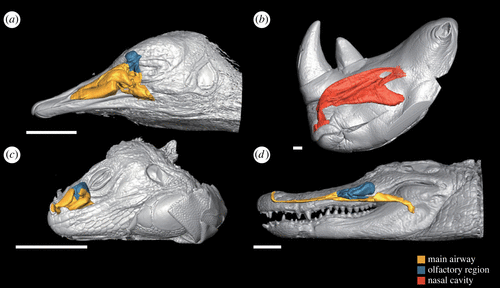Science & Technology
Connection Between Dinosaurs and Birds
- 10 Aug 2023
- 7 min read
For Prelims: Connection Between Dinosaurs and Birds, Cranial Evolution, Endothermic Animals, Theropod Lineage.
For Mains: Connection Between Dinosaurs and Birds.
Why in News?
Recently, a study published in the journal Royal Society Open Science, suggests a connection between Birds and Dinosaurs.
What is the Methodology of Research?
- The Researchers employed cutting-edge techniques, including Computed Tomography (CT) scans and 3D reconstruction, to analyze the nasal cavities of 51 present-day species.
- These species encompassed birds, mammals, reptiles (including crocodiles and turtles), and lizards. Additionally, the researchers digitally reconstructed the nasal cavity of a velociraptor, a type of theropod dinosaur, based on fossils.
- They focussed primarily on the nasal cavity to enhance understanding of the cranial evolution (changes in organism's skull over time) from dinosaurs to birds.
- They explored the possibility that the nasal cavity played a crucial role in brain cooling and regulation.
What are the Key Findings of the Study?
- Nasal Cavity Size and Warm-Bloodedness:
- Endothermic (Warm-blooded) animals, including birds and mammals, had larger nasal cavities relative to their head sizes compared to cold-blooded animals.
- This size difference indicated a potential link between warm-bloodedness and nasal cavity dimensions.
- Respiratory Turbinates and Brain Cooling:
- Warm-blooded animals exhibited a complex structure known as the respiratory turbinate within their nasal cavities. One of the primary functions of this structure was brain cooling.
- This discovery challenged the previously held belief that larger nasal cavities primarily facilitated whole-body metabolism.
- Warm-blooded animals exhibited a complex structure known as the respiratory turbinate within their nasal cavities. One of the primary functions of this structure was brain cooling.
- Evolutionary Implications for Dinosaurs and Birds:
- The cooling mechanism might have provided an advantage for warm-blooded creatures, including birds and mammals, influencing their evolution.
- In contrast, the reconstructed nasal cavity of the velociraptor indicated a lack of a developed cooling system, suggesting differences in thermoregulation between theropod dinosaurs and modern birds.
- Influence of Maxilla on Nasal Passage:
- The shape of the nasal passage in the velociraptor was influenced by the maxilla, the lower jaw bone.
- They proposed that a reduction in the maxilla in the theropod lineage led to the nasal cavity becoming a crucial apparatus for their thermal regulation strategy.
What is the Significance of the Study?
- While the study provided novel insights into the potential function of respiratory turbinates in brain cooling, the researchers emphasized the need for more comprehensive research to validate their hypotheses.
- Understanding the complex interplay between anatomical adaptations and environmental factors remains a key focus for future studies.
What are Warm Blooded and Cold Blooded Animals?
| Aspect | Warm-Blooded Animals (Endotherms) | Cold-Blooded Animals (Ectotherms) |
| Metabolism | High metabolic rate | Low metabolic rate |
| Body Temperature | Maintain a relatively constant body temperature independent of the environment | Body temperature varies with the external environment |
| Energy Source | Rely on internal heat production (metabolism) to maintain body temperature | Depend on external sources of heat for thermoregulation |
| Activity Levels | Can be active in a wide range of environmental conditions | Activity levels influenced by temperature; often more active in warmer conditions |
| Adaptability to Environments | Can inhabit diverse environments due to their ability to regulate body temperature | Limited in their habitat choices by temperature preferences |
| Reproductive Rate | Generally have lower reproductive rates due to high energy demands | May have higher reproductive rates due to lower energy demands |
| Examples | Mammals (including humans), birds | Reptiles (such as snakes, lizards), amphibians, most fish, invertebrates (except some insects) |
What is the Theory of Evolution by Charles Darwin?
- About:
- Charles Darwin's theory of evolution is a foundational concept in biology that explains how species change over time and how new species arise.
- Darwin's ideas revolutionized the understanding of life on Earth and provided a comprehensive explanation for the diversity of species.
- Key Elements:
- Descent with Modification: Darwin proposed that all species share common ancestors and that species change gradually over time through a process called descent with modification, meaning that new species arise from existing ones.
- Natural Selection: The central mechanism of Darwin's theory is natural selection. He observed that in every generation, more offspring are produced than can survive due to limited resources, leading to a struggle for survival.
- Variation: Within any population, there is variation in traits among individuals. Some of these variations are heritable, meaning they can be passed down to offspring.
- Adaptation: As natural selection acts on the variations in a population, individuals with traits that are better suited to their environment become more successful at surviving and reproducing.
- Speciation: Over long periods of time and through the accumulation of gradual changes, populations can become so different from each other that they can no longer interbreed. This leads to the formation of new species.
What is Computed Tomography (CT)?
- It is a medical imaging technique that uses X-rays and advanced computer processing to create detailed cross-sectional images of the body.
- Like an X-ray, it shows structures inside the body. But instead of creating a flat, 2D image, a CT scan takes dozens to hundreds of images of the body.
- Healthcare providers use CT scans to see things that regular X-rays can’t show.
- For example, body structures overlap on regular X-rays and many things aren’t visible.
- A CT shows the details of each of the organs for a clearer and more precise view.





